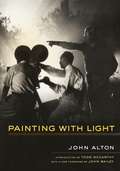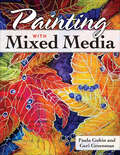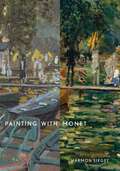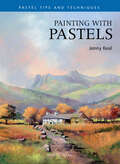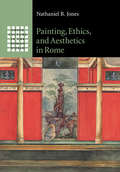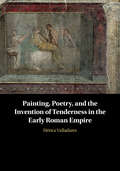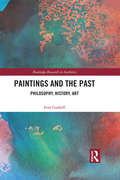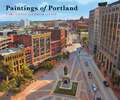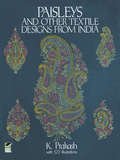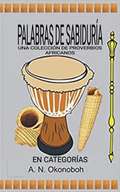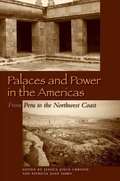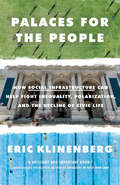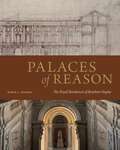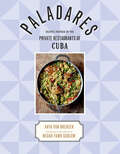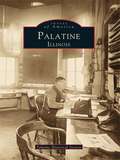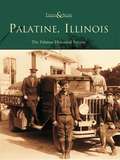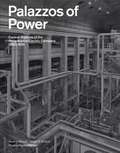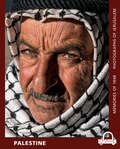- Table View
- List View
Painting with Light
by John AltonThis introduction to the workings of the Hollywood system provides a rich and accessible detail about special effects, technical wizardry and gadgetry, lighting, make-up, the breakdown of crews, and filming strategies.
Painting with Mixed Media
by Paula Guhin Geri GreemanA gorgeously illustrated guide to exploring the creative possibilities of multiple materials in your arts and crafts. Learn how to use painting mediums such as acrylic, watercolor, oil paint, ink, tempera, and pastels in combination with glazes, gesso, wax, and other materials for use in collages, scrapbooks, memory boxes, photo albums, and individual art pieces. For beginners to mixed-media painting as well as those who seek to expand their knowledge and skills with new ideas, techniques, or combinations, this guide opens up new creative paths and possibilities. Each chapter features a different painting medium, exploring the ways it can be combined with other materials, and ends with spin-off suggestions that challenge you to continue exploring. Also included are a gallery of inspiring artwork from eight mixed-media artists and a list of resources for art materials.
Painting with Monet
by Harmon SiegelA major reassessment of the methods and meaning of impressionismAt pivotal moments in his career, Claude Monet would go out with a fellow artist, plant his easel beside his friend&’s, and paint the same scene. Painting with Monet closely examines pairs of such works, showing how attention to this practice raises tantalizing new questions about Monet&’s art and about impressionism as a movement.Is impressionist painting an objective attempt to capture reality as it really is? Or is it a subjective expression of the artist&’s unique way of perceiving things? How can artists create a movement without conformity extinguishing individuality? Harmon Siegel reveals how Monet explored problems like these in concrete, practical ways while painting alongside his teachers, Eugène Boudin and Johan Barthold Jongkind; his friends, Frédéric Bazille and Pierre-Auguste Renoir; and his hero, Édouard Manet. At a time of major cultural upheavals, these artists asked how we can know reality beyond our personal perception. Siegel provides new insights into the aesthetic, philosophical, and ethical stakes for these painters as they responded to a rapidly changing society.Beautifully illustrated, Painting with Monet sheds critical light on how Monet and his fellow impressionists, painting side by side, professed their capacity to know the world and affirmed their belief in what Siegel calls the reality of others.
Painting with Pastels
by Jenny KealJenny Keal shares her passion for soft pastels in this inspiring and practical guide. She takes us through the basics of painting such as composition, colour theory and composition. There are then five beautiful step-by-by step demonstrations showing how to paint landscapes and flower studies, with plenty of useful tips for anyone wishing to paint with pastels, this most 'expressive and immediate' of mediums.
Painting with Pastels
by Leslie B. De MilleProvide tips and techniques on how to paint with pastels.
Painting with Pastels: Easy Techniques to Master the Medium
by Maggie PriceCome enjoy the art of pastel painting with beloved workshop instructor Maggie Price. In this step-by-step guide, she teaches you everything you need to know to make the most of this accessible art form. From selecting the right materials to learning the fundamentals of composition, Maggie starts with the basics and progresses to 21 complete pastel demonstrations that detail specific painting techniques and effects. You'll learn how to: Create depth and movement with color Paint using a range of strokes Blend colors to create luminous skies, reflections and more Underpaint to achieve brilliant light and deep shadows Mix pastels with watercolor and gouache to create fluid effects Create new compositions from photographs In addition to step-by-step guidance, you'll be inspired by the work of ten nationally renowned pastel artists. Their contributions to this book illustrate the limitless possibilities of pastel painting and offer additional insight for working with this versatile medium. Maggie also includes dozens of helpful sidebars to help you save time, avoid mistakes and work more efficiently. With its blend of visual instruction, thorough guidance and breathtaking artwork, this is the only guide you need to experience the joy and satisfaction of painting with pastels.
Painting with Wool: 16 Artful Projects to Needle Felt
by Dani IvesLearn how to needle felt and create stunning works of fiber art to wear, hang on the wall, and more with this guide and collection of sixteen projects.Painting with Wool is the introductory and must-have text for fiber artists and other crafters looking for a new and exciting art form to explore. Increasingly popular, Dani Ives’s style of needle felting uses wool fibers and a felting needle to layer and “paint” embellishments for pieces that are bursting with texture and depth. Whether you want to decorate a tote or garment, or create frameable artwork, Painting with Wool is the guide to everything you need to know—including the tools required, the basic techniques, and how to get started. For fiber lovers who want to broaden their skills, needle felting is an easy, therapeutic form of self-expression that offers beautiful, unique results. Ives is a pioneer in this art form and a skilled instructor who makes learning this craft fun and approachable for all.
Painting, Ethics, and Aesthetics in Rome (Greek Culture in the Roman World)
by Nathaniel B. JonesIn the first centuries BCE and CE, Roman wall painters frequently placed representations of works of art, especially panel paintings, within their own mural compositions. Nathaniel B. Jones argues that the depiction of panel painting within mural ensembles functioned as a meta-pictorial reflection on the practice and status of painting itself. This phenomenon provides crucial visual evidence for both the reception of Greek culture and the interconnected ethical and aesthetic values of art in the Roman world. Roman meta-pictures, this book reveals, not only navigated social debates on the production and consumption of art, but also created space on the Roman wall for new modes of expression relating to pictorial genres, the role of medium in artistic practice, and the history of painting. Richly illustrated, the volume will be important for anyone interested in the social, ethical, and aesthetic dimensions of artworks, in the ancient Mediterranean and beyond.
Painting, Poetry, and the Invention of Tenderness in the Early Roman Empire
by Herica ValladaresTenderness is not a notion commonly associated with the Romans, whose mythical origin was attributed to brutal rape. Yet, as Hérica Valladares argues in this ground-breaking study, in the second half of the first century BCE Roman poets, artists, and their audience became increasingly interested in describing, depicting, and visualizing the more sentimental aspects of amatory experience. During this period, we see two important and simultaneous developments: Latin love elegy crystallizes as a poetic genre, while a new style in Roman wall painting emerges. Valladares' book is the first to correlate these two phenomena properly, showing that they are deeply intertwined. Rather than postulating a direct correspondence between images and texts, she offers a series of mutually reinforcing readings of painting and poetry that ultimately locate the invention of a new romantic ideal within early imperial debates about domesticity and the role of citizens in Roman society.
Painting, Science, and the Perception of Coloured Shadows: ‘The Most Beautiful Blue’ (Science and the Arts since 1750)
by Paul SmithMany artists and scientists – including Buffon, Goethe, and Philipp Otto Runge – who observed the vividly coloured shadows that appear outdoors around dawn and dusk, or indoors when a candle burns under waning daylight, chose to describe their colours as ‘beautiful’. Paul Smith explains what makes these ephemeral effects worthy of such appreciation – or how depictions of coloured shadows have genuine aesthetic and epistemological significance. This multidisciplinary book synthesises methodologies drawn from art history (close pictorial analysis), psychology and neuroscience (theories of colour constancy), history of science (the changing paradigms used to explain coloured shadows), and philosophy (theories of perception and aesthetic value drawn from Wittgenstein and Merleau-Ponty). This title will be of interest to scholars in art history, art theory, and the history of science and technology.
Painting, Science, and the Perception of Coloured Shadows: ‘The Most Beautiful Blue’ (Science and the Arts since 1750)
by Paul SmithMany artists and scientists – including Buffon, Goethe, and Philipp Otto Runge – who observed the vividly coloured shadows that appear outdoors around dawn and dusk, or indoors when a candle burns under waning daylight, chose to describe their colours as ‘beautiful’. Paul Smith explains what makes these ephemeral effects worthy of such appreciation – or how depictions of coloured shadows have genuine aesthetic and epistemological significance. This multidisciplinary book synthesises methodologies drawn from art history (close pictorial analysis), psychology and neuroscience (theories of colour constancy), history of science (the changing paradigms used to explain coloured shadows), and philosophy (theories of perception and aesthetic value drawn from Wittgenstein and Merleau-Ponty). This title will be of interest to scholars in art history, art theory, and the history of science and technology.
Paintings and the Past: Philosophy, History, Art (Routledge Research in Aesthetics)
by Ivan GaskellThis book is an exploration of how art—specifically paintings in the European manner—can be mobilized to make knowledge claims about the past. No type of human-made tangible thing makes more complex and bewildering demands in this respect than paintings. Ivan Gaskell argues that the search for pictorial meaning in paintings yields limited results and should be replaced by attempts to define the point of such things, which is cumulative and ever subject to change. He shows that while it is not possible to define what art is—other than being an open kind—it is possible to define what a painting is, as a species of drawing, regardless of whether that painting is an artwork or not at any given time. The book demonstrates that things can be artworks on some occasions but not necessarily on others, though it is easier for a thing to acquire artwork status than to lose it. That is, the movement of a thing into and out of the artworld is not symmetrical. All such considerations are properly matters not of ontology—what is and what is not an artwork—but of use; that is, how a thing might or might not function as an artwork under any given circumstances. These considerations necessarily affect the approach to paintings that at any given time might be able to function as an artwork or might not be able to function as such. Only by taking these factors into account can anyone make viable knowledge about the past. This lively discussion ranges over innumerable examples of paintings, from Rembrandt to Rothko, as well as plenty of far less familiar material from contemporary Catholic devotional works to the Chinese avant garde. Its aim is to enhance philosophical acuity in respect of the analysis of paintings, and to increase their amenability to philosophically satisfying historical use. Paintings and the Past is a must-read for all advanced students and scholars concerned with philosophy of art, aesthetics, historical method, and art history.
Paintings of Portland
by David Little Carl LittleThe city of Portland and its surroundings, including the islands of Casco Bay, have inspired a wide range of art over the past 200 years. The &“city by the sea,&” as Longfellow famously called it, has been a visual talisman for a host of artists, from early masters like Harrison Bird Brown and John Bradley Hudson to a remarkable roster of contemporary painters. Subjects include many of the city&’s signature buildings, including the Custom House and Portland Head Light, as well as street scenes, the waterfront, harbor, back bay, and surrounding landscapes—even the Million Dollar Bridge. Paintings of Portland will feature a wide range of motifs, in all seasons and represented by an array of styles. About a quarter of the book will be devoted to historical pieces, the rest to paintings by contemporary artists.
Paisleys and Other Textile Designs from India (Dover Pictorial Archive)
by K. PrakashOver 500 splendid motifs, adapted from elegant brocades, include colorful block prints and woven designs inspired by nature -- trees, leaves, flowers, buds, animals, and birds. This volume constitutes a superb, comprehensive sourcebook for artists, art historians, textile designers, needleworkers, fabric painters, and other craft enthusiasts.
Pakwagen SDKFZ 234/3 and 234/4 Heavy Armoured Cars: German Army, Waffen-SS and Luftwaffe Units—Western and Eastern Fronts, 1944–1945 (LandCraft #11)
by Dennis Oliver"...squeezes a lot of useful information into a modest 64 pages and is a useful addition to any library of German armored cars." — War WheelsExperience in the Polish and French campaigns had convinced the German high command of the value of fast-moving, armed reconnaissance vehicles. But it was realised that many of the early designs were too lightly-armed and development of a heavy eight-wheeled prototype resulted in the Sdkfz 234 series of armored cars, the first of which entered service in late 1943. Built by the firm of Büssing-NAG, these sturdy and reliable vehicles were gradually up-armed and served in the infantry support role and eventually as tank killers, largely as the result of Hitler's desperation to arm as many vehicles as possible with anti-tank weapons. Drawing on official documentation and unit histories Dennis investigates the formations that operated these vehicles and uses archive photos and extensively researched color illustrations to examine the markings, camouflage and technical aspects of the Sdkfz 234/2, 234/3 and 234/4 armored cars that served on the Western and Eastern Fronts in the last months of the war. A key section of his book displays available model kits and aftermarket products, complemented by a gallery of beautifully constructed and painted models in various scales. Technical details as well as modifications introduced during production and in the field are also examined, providing everything the modeller needs to recreate an accurate representation of these historic vehicles.
Palabras de sabiduría: Una colección de proverbios africanos en categorías
by A. N. OkonobohRepleto de palabras de sabiduría, refranes sabios, viejos refranes, filosofía de sabios y cultura antigua, encuentre en la portada que esta colección de proverbios africanos posee el título apropiado. El libro y su contenido es diferente de la tormenta de proverbios en las obras de sabiduría de Oriente. La antología es amplia para incluir dichos para mujeres y hombres, niños y padres, salmos nupciales, plantas y animales, realidad y abstracto, esencial y trivial y novias y novios. La cuna de la civilización del África faraónica y los mitos y leyendas ingeniosas de los continentes se destacan con colores culturales. Y el trabajo echa a un lado la cortina de estas joyas tradicionales orales, yendo así como misioneros en la tierra de las culturas extranjeras. Como lector, verá más en el libro, pintado con palabras vivas, la identidad africana y el arte de la historia que a menudo se encuentra presente en la ropa, el edredón, la almohada, la placa, los pendientes, las pulseras, el collar y los regalos, junto con citas y ritmos divertidos. Los proverbios y acertijos son una parte importante de la vida tradicional africana. Buscan sacar a relucir una gama de consejos reflexivos, comprensión, verdad, moral y advertencias tanto en forma seria como humorística. Evocan significados de las experiencias diarias, muestran la unidad de la comunidad y el vínculo con la espiritualidad bíblica. La belleza de esta colección es la generosa latitud hacia muchos posibles significados ya que no se intenta sugerir uno. A menos que se indique lo contrario, todos los proverbios aquí se atribuyen a los Ishans, una pequeña tribu minoritaria de Edo, Nigeria. Sin embargo, la mayoría son conocidos en otras tribus y sus mensajes son verdaderos para la gente de todas partes. Este libro ganará audiencia entre las familias y los lectores que buscan encontrar la sabiduría de las palabras. Así que descubre por qué "Un niño pequeño no tiene un
Palaces and Power in the Americas: From Peru to the Northwest Coast
by Jessica Joyce Christie Patricia Joan SarroAncient American palaces still captivate those who stand before them. Even in their fallen and ruined condition, the palaces project such power that, according to the editors of this new collection, it must have been deliberately drawn into their formal designs, spatial layouts, and choice of locations. Such messages separated palaces from other elite architecture and reinforced the power and privilege of those residing in them. Indeed, as Christie and Sarro write, "the relation between political power and architecture is a pervasive and intriguing theme in the Americas. " Given the variety of cultures, time periods, and geographical locations examined within, the editors of this book have grouped the articles into four sections. The first looks at palaces in cultures where they have not previously been identified, including the Huaca of Moche Site, the Wari of Peru, and Chaco Canyon in the U. S. Southwest. The second section discusses palaces as "stage sets" that express power, such as those found among the Maya, among the Coast Salish of the Pacific Northwest, and at El Tajín on the Mexican Gulf Coast. The third part of the volume presents cases in which differences in elite residences imply differences in social status, with examples from Pasado de la Amada, the Valley of Oaxaca, Teotihuacan, and the Aztecs. The final section compares architectural strategies between cultures; the models here are Farfán, Peru, under both the Chimú and the Inka, and the separate states of the Maya and the Inka. Such scope, and the quality of the scholarship, make Palaces and Power in the Americas a must-have work on the subject.
Palaces for the People: How Social Infrastructure Can Help Fight Inequality, Polarization, and the Decline of Civic Life
by Eric KlinenbergAn eminent sociologist and bestselling author offers an inspiring blueprint for rebuilding our fractured society. We are living in a time of deep divisions. Americans are sorting themselves along racial, religious, and cultural lines, leading to a level of polarization that the country hasn’t seen since the Civil War. Pundits and politicians are calling for us to come together, to find common purpose. But how, exactly, can this be done? In Palaces for the People, Eric Klinenberg suggests a way forward. He believes that the future of democratic societies rests not simply on shared values but on shared spaces: the libraries, childcare centers, bookstores, churches, synagogues, and parks where crucial, sometimes life-saving connections, are formed. These are places where people gather and linger, making friends across group lines and strengthening the entire community. Klinenberg calls this the “social infrastructure”: When it is strong, neighborhoods flourish; when it is neglected, as it has been in recent years, families and individuals must fend for themselves. Klinenberg takes us around the globe—from a floating school in Bangladesh to an arts incubator in Chicago, from a soccer pitch in Queens to an evangelical church in Houston—to show how social infrastructure is helping to solve some of our most pressing challenges: isolation, crime, education, addiction, political polarization, and even climate change. Richly reported, elegantly written, and ultimately uplifting, Palaces for the People urges us to acknowledge the crucial role these spaces play in civic life. Our social infrastructure could be the key to bridging our seemingly unbridgeable divides—and safeguarding democracy.
Palaces of Reason: The Royal Residences of Bourbon Naples
by Robin L. ThomasPalaces of Reason traces the fascinating history of three royal residences built outside of Naples in the eighteenth century at Capodimonte, Portici, and Caserta. Commissioned by King Charles of Bourbon and Queen Maria Amalia of Saxony, who reigned over the Kingdom of the Two Sicilies, these buildings were far more than residences for the monarchs. They were designed to help reshape the economic and cultural fortunes of the realm.The palaces at Capodimonte, Portici, and Caserta are among the most complex architectural commissions of the eighteenth century. Considering the architecture and decoration of these complexes within their political, cultural, and economic contexts, Robin L. Thomas argues that Enlightenment ideas spurred their construction and influenced their decoration. These modes of thinking saw the palaces as more than just centers of royal pleasure or muscular assertions of the crown’s power. Indeed, writers and royal ministers viewed them as active agents in improving the cultural, political, social, and economic health of the kingdom. By casting the palaces within this narrative, Thomas counters the assumption that they were imitations of Versailles and the swan songs of absolutism, while expanding our understanding of the eighteenth-century European palace more broadly.Original and convincing, Thomas’s book will be of interest to historians of art and architectural history and eighteenth-century studies.
Paladares: Recipes Inspired by the Private Restaurants of Cuba
by Anya von BremzenDiscover the fresh flavors of contemporary Cuba in this gorgeously photographed volume of stories and recipes from the country&’s enterprising restaurants. Over the past decades, paladares—or private restaurants—have led a cultural and culinary renaissance in Cuba. In Paladares, James Beard Award-winning food writer Anya von Bremzen shares a fascinating journey through the country&’s new food scene. Born in Soviet Russia, Bremzen brings a unique perspective to the stories she hears from Cuba&’s chefs, restaurateurs, farmers, and food historians. She eavesdrops on passionate arguments about black beans and tamales; pries Daiquirí secrets from the legendary El Floridita (Hemingway&’s watering hole); and guides us to vibrant markets and visionary organic farms. Through Bremzen&’s travels, we learn of Fidel&’s obsession with dairy cows and hear wrenching memories of privation from the time after Soviet aid vanished. We meet colorful expats-turned-restaurateurs and local hipsters who obsess over global culture glimpsed in foreign movies and magazines. The more than 100 recipes in Paladares are as intriguing as the characters behind them. And Fawn Schlow&’s evocative photographs frame it all with the ramshackle glamour of old Havana, Cuba&’s stunning countryside, dishes that are earthy and innovative, and Cuba&’s incredible people.
Palatine, Illinois
by Palatine Historical SocietyPalatine was incorporated as a village at a meeting of voters held April 2, 1866. The town then experienced a slow, steady growth, and the first development on a large scale started around 1920. In 1925 farms were selling for $400 an acre, a sewer system had just been completed, the streets were paved with reinforced concrete, and elaborate street lighting had been installed. Through the years, the Palatine Historical Society has developed an extensive collection of photographs dating back close to the beginning of Palatine Township and theVillage of Palatine. Many of these treasured photos were donations from the families of earlier residents. Efforts have been made by Alice Rosenberg and the Palatine Historical Society to identify the people and places in the historic photos contained herein. Through the use of this collection, the Palatine Historical Society has put together a fascinating book that serves as a tribute to the preservation efforts put forth in the Village ofPalatine. In the 133 years since the Village of Palatine was incorporated, numerous annexations have occurred, and many subdivisions have been built. The small, farm village located about 35 miles from the center of Chicago, out on the prairie, is now a suburb with a population of 62,000.
Palatine, Illinois
by The Palatine Historical SocietyMoving toward the future while maintaining its historic past, Palatine, Illinois, was incorporated in 1866 and has seen great change and growth through the years. That change is captured here in a collection of vintage and contemporary images that trace the evolution of this Midwestern farm village into a big city suburb.Authored by the Palatine Historical Society and Alice Rosenberg, Palatine, Illinois: Then and Now illustrates how the area looked when it was first settled, how it developed through the years, and what it has become. From the generations of Palatine residents who lived, worked, and played in the area to the thriving municipality they created, the images contained in this book bring to life a fascinating evolution.
Palazzo Inverso
by D. B. JohnsonMauk, mischievous apprentice to the master architect, must not draw on the plans for the new Palazzo. But by turning the plans a bit each day, he finds a way to alter them, turning the master’s creation onto its head! Discover what mystery and excitement a small change of perspective has brought to the Palazzo. In this M. C. Escher-inspired masterpiece, D. B. Johnson pushes the picture book form to new extremes. With its continuous narrative and illustrations that can viewed upside down, readers can turn the book over on page thirty two and read all the way back to page one. Enter the Palazzo Inverso. . . and see if you can find your way out.
Palazzos of Power: Central Stations of the Philadelphia Electric Company, 1900-1930
by David E. Nye Aaron V. Wunsch Joseph E.B. Elliott"If it isn't Electric, it isn't Modern." Such was the slogan of the Philadelphia Electric Company, developer of an unprecedented network of massive metropolitan power stations servicing greater Philadelphia at the turn of the twentieth century. These once-brilliant sentinels of civic utility and activity were designed to convey "solidity and immensity" in an age of deep public skepticism. They now stand vacant and decaying, a "blight" in the eyes of city planners and a beacon to urban explorers.The first book on the buildings and machines that made possible the electrification of the United States, Palazzos of Power offers a visual and analytical exploration of architecture, technology, place, loss, and reuse. With a foreword by David Nye, this collection of Joseph Elliott's beautiful large-format photographs reveal the urban landscape, monumental spaces, giant machinery, and intricate controls that made up the central station. Aaron Wunsch's essay provides historical context on the social and political climate.
Palestine Memories of 1948: Photographs of Jerusalem
by Chris ContiSeventy-one years ago, in 1948, the Nakba—the "catastrophe"—overturned life in Palestine, forcing three-quarters of Palestinians into exile, depriving them of their land, their homes, their belongings. Today, those who can bear witness to that period are becoming rare. From different social backgrounds, 19 men and women remember the coexistence that prevailed in Palestine, the war, the exile, as well as the strength and resilience which they had to muster to adapt to new realities. Life stories expressed in the first person are accompanied by black and white portraits where each look questions the coming generations. For every Palestinian, Jerusalem is charged with symbolic meaning, of identity and of remembrance, the more so because it has become inaccessible to most. The city is made the focus of a compilation of color photographs presented for a contemporary look, between shadow and light.
